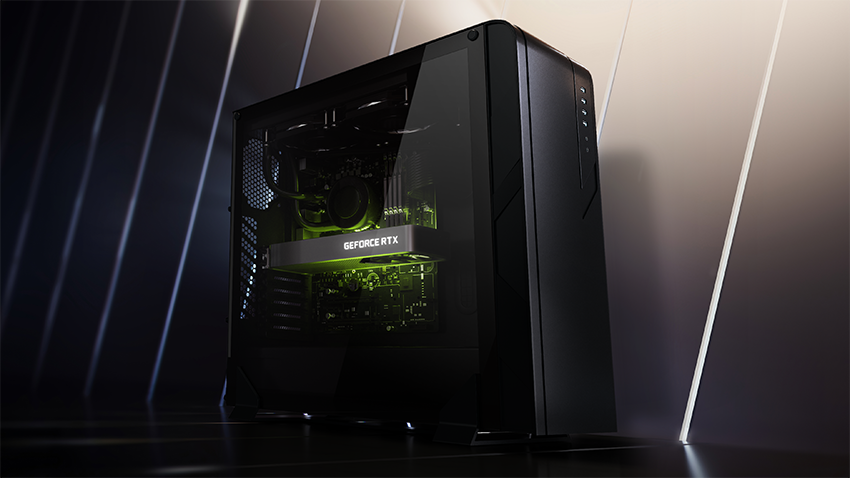CES 2021: NVIDIA Brings RTX Ray-Tracing And DLSS Technology To The Masses
- Soon Kai Hong

- Jan 13, 2021
- 4 min read
Updated: Aug 20, 2021
NVIDIA has been at the forefront of graphics technology for quite a long time and they honestly still are. During CES 2021, they are taking the best technology that they have on offer to the masses in both the desktop and the laptop sector.
NVIDIA GeForce RTX 3060
NVIDIA mentioned that their 60-class GPUs have traditionally been the single most popular cards for the majority of gamers out there. As a fact, the GeForce GTX 1060 is still among the top of the GPU gaming charts on Steam since its introduction back in 2016. NVIDIA also estimates that about 90% of GeForce gamers are still playing on a GTX-class GPU, which means they do not get access to the latest features such as Ray-Tracing and DLSS (Deep Learning Super Sampling).
The GeForce RTX 3060 is set to change all that.
Built on the NVIDIA Ampere architecture and being the second generation of RTX, the GeForce RTX 3060 is all set to bring hardware ray-tracing support as well as NVIDIA DLSS and other technologies at a really reasonable starting price of US$329.
Key specifications of the GeForce RTX 3060 include 13 shader-TFLOPs, 25 RT-TFLOPS for ray-tracing, 101 tensor-TFLOPs to power NVIDIA DLSS, a 192-bit memory interface and 12GB of GDDR6 VRAM. Compared to the GeForce GTX 1060, the GeForce RTX 3060 will be able to provide twice the raster performance and up to 10 times the ray-tracing performance. NVIDIA claims that it will be able to handle the eSports titles such as Fortnite with RTX On and even AAA titles like the latest Cyberpunk 2077 with RTX On and achieve 60 frames per second.
The NVIDIA GeForce RTX 3060 will be available in late February 2021 starting at US$329 for custom boards — including stock-clocked and factory-overclocked models — from top add-in card providers such as ASUS, Colorful, EVGA, Gainward, Galaxy, Gigabyte, Innovision 3D, MSI, Palit, PNY, Zotac and more.
Resizable BAR
Alongside the release of the GeForce RTX 3060, NVIDIA will also be enhancing the currently available GeForce RTX 30 Series for both laptops and desktops with a new optional PCI Express interface technology that can increase performance in games, called Resizable BAR.
Here’s a bit of context. As you move about the world in a game, GPU memory (VRAM) is constantly transferring textures, shaders and geometry via many small CPU to GPU transfers, like small little packets one after the other. As the ambitions of game developers grow bigger, so does modern game assets and this results in a lot of such transfers. With Resizable Bar, assets can instead be requested as and when needed and sent in the full chunk, allowing the CPU to access the entire frame buffer at any instance. And if and when multiple requests are made, the transfers can occur concurrently rather than queuing. This effectively allows games to grab chunks of information involving the use of VRAM much quicker and in larger volumes, which can directly improve performance in said game.
A ‘free’ performance increase without any additional cost? We will take it, please.
GeForce RTX 30 Series laptops with both Intel and AMD CPUs will be able to support Resizable BAR when they are released in the coming weeks. Support may vary from system to system. To enable this feature on desktops, the graphics card, motherboard and graphics drivers will all need to support the feature. GeForce RTX 3060 will have support for Resizable Bar on the day of launch while VBIOS updates will be released for existing GeForce RTX 30 Series graphics cards starting in March 2021.
GeForce RTX 30 Series Laptops
Since RTX 30 Series graphics cards were launched for desktops, many were anticipating the laptop variants to quickly follow suit. Well, NVIDIA has finally announced them.
These next-gen laptops will be powered by GeForce RTX 30 Series Laptop GPUs built upon the Ampere architecture, include Max-Q technologies and will start from US$999. For a start, three GPUs will be available – The GeForce RTX 3060, RTX 3070 and RTX 3080. NVIDIA claims that the GeForce RTX 3060 will be able to deliver 90 frames per second on the latest games with ultra settings at 1080p and will be faster than laptops featuring the previous flagship GPU, the GeForce RTX 2080 Super. The GeForce RTX 3070 will take it up a notch and deliver 90 frames per second with ultra settings at 1440p and will be about 50% faster compared to laptops equipped with the previous generation’s GeForce RTX 2070. As for the GeForce RTX 3080, that needs no further explanation. With up to 16GB of GDDR6 VRAM, it is the flagship and will provide upwards of 100 frames per second with ultra settings at 1440p.
Along with the new series of graphics card is the third generation of Max-Q technology which includes a couple of new technologies.
The first is Dynamic Boost 2.0. With the power of AI, Dynamic Boost 2.0 will be able to balance the power between the CPU, GPU and the GPU memory (VRAM), depending on where it is needed the most at any particular instance during any sort of workload, ensuring maximum performance via optimisation.
The second is WhisperMode 2.0. Building upon the previous generation, users will be able to select the desired acoustic setting and once selected, will make use of AI-powered algorithms to manage the CPU, GPU and fan speeds to control the system temperatures while providing great acoustics without any compromise to the performance.
GeForce RTX 30 Series laptops will be available starting from 26 January 2021 from OEMs including Acer, Alienware, ASUS, Gigabyte, HP, Lenovo, MSI, Razer and more. They will also be available from local OEMs and system builders like Aftershock. Pricing, configurations and availability will vary among regions and partners.
Written by Soon Kai Hong








